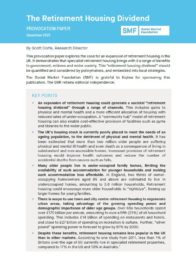This provocation paper explores the case for an expansion of retirement housing in the UK. It demonstrates that specialist retirement housing brings with it a range of benefits to government, retirees and wider society. This “retirement housing dividend” should be quantified and considered by policymakers, and embedded into local strategies.
KEY POINTS
- Expanding retirement housing could generate a societal “retirement housing dividend” through a range of channels. This includes gains to physical and mental health and a more efficient allocation of housing with reduced rates of under-occupation. A “community hub” model of retirement housing can also help cost-effective provision of facilities such as gyms and libraries to the wider public.
- The UK’s housing stock is currently poorly placed to meet the needs of an ageing population, to the detriment of physical and mental health. It has been estimated that more than two million older people are suffering physical and mental ill health and even death as a consequence of living in substandard and non-accessible homes. Increased provision of retirement housing would improve health outcomes and reduce the number of accidental deaths, from causes such as falls.
- Many older people live in under-occupied family homes, limiting the availability of such accommodation for younger households and making it less affordable. In England, two thirds of owner-occupying homeowners aged 65 and above are estimated to live in under-occupied homes, amounting to 3.6 million households. Retirement housing could encourage more older households to “rightsize”, freeing up larger homes for young families.
- There is scope to use town and city centre retirement housing to regenerate urban areas, taking advantage of the growing spending power and demographic importance of older age groups. Over 65s households spend over £170 billion per annum, amounting to over a fifth (21%) of all household spending. This includes £14 billion of spending on restaurants and hotels, and close to £27 billion of spending on recreation & culture. Further, “silver pound” spending power is forecast to grow by 81% by 2030.
- Despite these benefits, retirement housing remains less popular in the UK than in other markets. According to one study from 2011, less than 1% of Britons over the age of 60 currently live in specialist retirement properties, compared to 17% in the US and 13% in Australia
WHERE NEXT FOR POLICY?
- Policymakers need to get better at capturing the full gamut of benefits flowing from retirement housing, and use this to inform decision making. In this paper, we have set out a broad approach for assessing such benefits and quantifying the retirement housing dividend. This could form the basis of a formalised approach for appraising the case for a particular retirement development.
- Integrated Care Systems (ICSs) should play a key role in building a more aligned and coordinated approach to commissioning and developing age-appropriate housing that facilitates health improvements. With ICSs set to be put on a statutory footing from next year, policymakers should consider the role of housing and planning within the formalised accountabilities of ICSs.
- Homes England also has a role to play in stimulating the construction of affordable retirement housing. There are a number of ways in which this could work in practice. For example, an explicit target could be set for new retirement homes supported by Homes England. It could also undertake are view of public land and identify sites that would be particularly well-suited for retirement housing in terms of the likely retirement housing dividend. Grant funding should be considered as a way of stimulating construction of new retirement housing in such areas.
- Policymakers and the developer community need to work together to deliver high-quality retirement accommodation in the right places, to encourage more older individuals to consider it as an option. It has been argued that factors currently limiting the choice of retirement housing include:
- Housing and planning issues, including a lack of imaginative ideas, strategic vision and data on older people’s housing.
- Specialist retirement developers often offering limited models, and general house-builders not designing for or targeting older people.
- Limited use of creative partnerships between general house-builders, specialist retirement developers, housing associations and local authorities.

DOWNLOAD THE PAPER: PDF
Kindly sponsored by

